New Light on Adult Literacy and Numeracy in Scotland: Evidence from the 2004 survey of the 1970 British Cohort Study (BCS70)
This report gives the results of a separate analysis for Scotland of literacy and numeracy data collected in the 1970 British Cohort Study at age 34. It relates performance in these skills to a wide range of other features of Scottish cohort members' lives.
Chapter 4 Early life experiences - family background, socio-economic disadvantage and family support measures
At each stage of development we all achieve a certain level of literacy and numeracy competence, which in turn influences later skills acquisition. There is a progressive build up of skills, or indeed difficulties, that occur throughout childhood. Adult literacy and numeracy acquisition can be seen as being underpinned by a number of interrelated family socio-economic and later educational experiences. In difficult, disadvantaged home and family circumstances, and if parents' own educational experiences had been poor, a crucial element of learning support may be missing in the early years of skills acquisition. It falls then to teachers to play an increased role in the skills development of children. In the next two Chapters we profile the early life experiences of cohort members living in Scotland in 2004, making use of the full range of information collected during their childhood, at their birth and ages 5, 10 and 16 21. In this Chapter we detail family socio-economic background, parental education and family support measures, and in Chapter 5 we look at early cognitive and educational achievement, together with identification of difficulties at early ages by parents, teachers and consider some characteristics of the school environment itself. These various indicators of skills acquisition will flag up key targets of intervention prior to adulthood.
Family background
Fixed characteristics present at birth such as sex and birth weight, together with social and economic factors in childhood, teenage motherhood and family social class, etc, cannot be changed, but it is important they are accounted for as research has shown that they relate to cognitive development (Wedge and Prosser, 1973; Pilling, 1990) or literacy and numeracy acquisition (Bynner and Steedman, 1995; Parsons and Bynner, 1998). Such variables are not direct influences on literacy and numeracy skills but are indicators reflecting social background or the economic conditions of the child's home-life, building up a picture of the type of home environment which works for or against the learning process. These fixed characteristics are built upon by circumstances and experiences later on in life.
As we saw in chapter 3, men are more likely than women to have more competence in literacy and numeracy, particularly numeracy. There were no differences across groups in average birthweight, but mothers of cohort members with SCQF Access Level 2 or 3 literacy were most likely to have been a teenage mother (27% to 13% SCQF Level 5 or higher literacy) .
Family social class, as derived from the father's occupation at the time cohort members were born in 1970, unsurprisingly showed differences across skills groups. Figure 4.1 shows that 1 in 4 fathers of cohort members with SCQF Access Level 2 or 3 literacy worked in unskilled or partly skilled manual jobs as did more than 1 in 4 fathers of cohort members with SCQF Access Level 2 or 3 numeracy skills. In contrast, more than 1 in 3 fathers of cohort members with SCQF Level 5 or higher literacy and numeracy held a professional or other white-collar occupation back in 1970. However, although there is a strong association between family social class and literacy and numeracy acquisition, coming from a manual, unskilled social class is not a precursor to skills difficulties in later life. The majority of children from such a background grow up to have a fine grasp of literacy and numeracy.
Figure 4.1: social class of family back in 1970 by cohort members grasp of literacy or numeracy at age 34
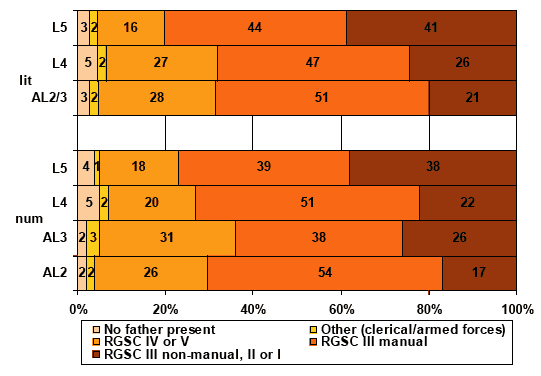
Socio-economic disadvantage during childhood
Overcrowding and housing
The first thing to note is that cohort members living in Scotland in 2004 were far less likely to live in an owner-occupied home, but far more likely to live in overcrowded conditions during childhood than in BCS70 overall. For example, at age 5 just 35% of Scottish cohort members lived in an owner-occupied home compared with 61% of cohort members across Great Britain ( GB) as a whole. Similarly 61% of Scottish cohort members lived in an overcrowded home compared with 36% in GB overall. Differences between skills groups in Scotland were just as marked as in GB overall. Figure 4.2 shows that 8 in 10 cohort members with SCQF Access Level 2 or 3 literacy or SCQF Access Level 2 numeracy grew up in an overcrowded home and no more than 2 in 10 in an owner-occupied home. Comparable figures for those with SCQF Level 5 or higher skills were around 1 in 2 living in an overcrowded home at age 5, increasing to 2 in 3 at age 10, while around half lived in an owner-occupied home at both age points. Completing the picture of childhood housing, just over half of all cohort members in Scotland lived in an 'inner city urban' or a 'council estate' environment at age 10, with those with the poorest skills being unsurprisingly the most likely to - highest at 88% of those with SCQF Access Level 2 or 3 literacy, 77% with SCQF Access Level 2 numeracy.
Figure 4.2: % cohort members living in an owner-occupied or overcrowded home at age 5 or 10 by grasp of literacy or numeracy at age 34
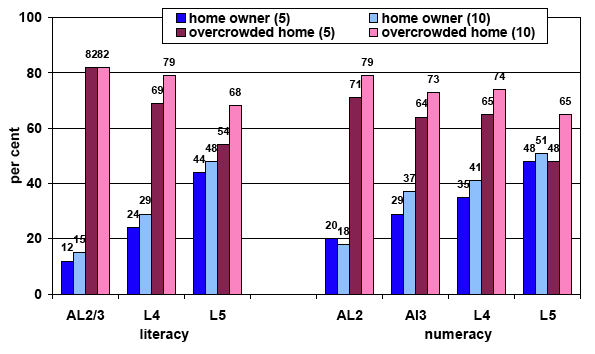
Financial circumstances
Many measures directly or indirectly assess the financial circumstances of cohort members during childhood. Figure 4.3 shows that far more cohort members with SCQF Access Level 2 or 3 literacy and, to a lesser extent, SCQF Access Level 2 and sometimes SCQF Access Level 3 numeracy grew up experiencing many aspects of economic disadvantage throughout their childhood, compared to cohort members with a better grasp of literacy or numeracy. For example, compared to those who grew up to have SCQF Level 5 or higher literacy, families of cohort members who grew up to only have an SCQF Access Level grasp of literacy were far less likely to have a phone (42% to 66%), a colour television (36% to 53%) or a car (44% to 71%) in 1975. They were far more likely to have had a low family income (53% to 29%) and to have received free school meals in 1980 (35% to 11%). In 1986, they were also more likely to have received state (unemployment or supplementary) benefits (41% to 23%) or to have reported experiencing financial hardship (27% to 9%). A picture is created of disadvantaged family circumstances preceding literacy and numeracy difficulties. Economic disadvantage is part of the whole syndrome of factors which work against educational progress and inhibits literacy and numeracy skills acquisition.
Figure 4.3 measures of economic disadvantage in childhood by cohort members grasp of literacy or numeracy at age 34
a) Literacy
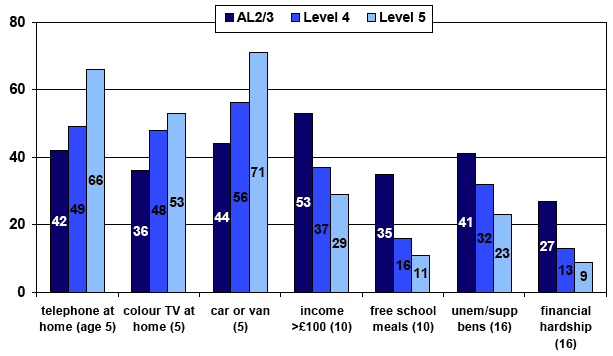
b) Numeracy
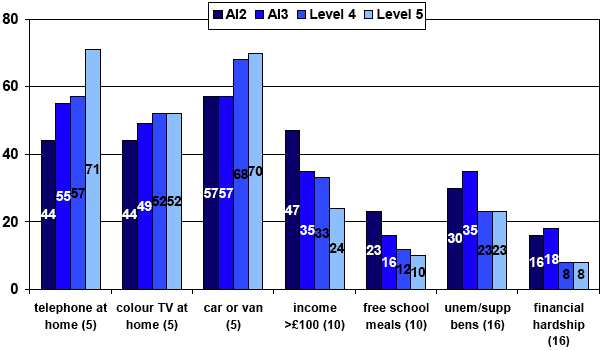
Family support factors
Parental education
The educational level of parents has an obvious relationship with the literacy and numeracy development in their children. Figure 4.4 shows that, compared to cohort members with SCQF Level 5 or higher skills, all other cohort members were less likely to have a parent who stayed on in post compulsory education, but this was lowest at just 1 in 7 mothers of cohort members with SCQF Access Level 2 or 3 literacy. Cohort members with SCQF Access Level skills were also far more likely to have a mother or father who had no formal qualifications at all in comparison with those with SCQF Level 5 or higher skills. Compared with those with SCQF Level 5 or higher skills, most likely of all to not have any qualifications were mothers or fathers of cohort members with SCQF Access Level 2 or 3 literacy (87% to 43% mothers, 67% to 36% fathers). Least likely of all to not have any qualifications were fathers of cohort members with SCQF Level 5 numeracy (32%). At the other end of the qualification scale, as many as 1 in 4 fathers of cohort members with SCQF Level 5 or higher numeracy had a degree (or equivalent) qualification compared with 1 in 20 fathers of cohort members with SCQF Access Level 2 numeracy or SCQF Access Level 2 or 3 literacy (5%).
Figure 4.4: % parents education and highest qualification level by cohort members grasp of literacy or numeracy at age 34
a) Literacy
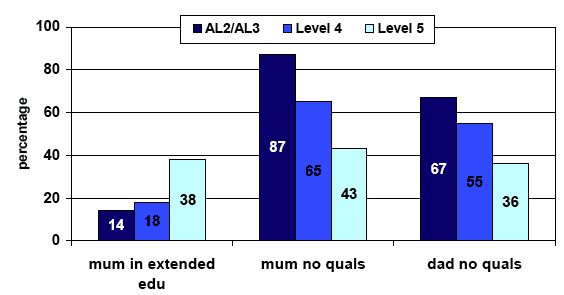
a) Numeracy
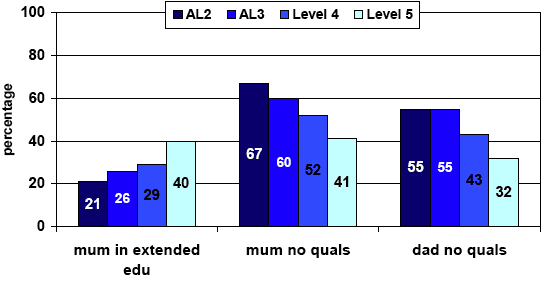
But what about parents grasp of the basics? In 1986, when cohort members were 16, parents were asked about any difficulties they had in learning to read or in reading at that time. As we will find when looking at levels of self-reported difficulties with reading or numbers among cohort members in adulthood, parents of our Scottish cohort members were less likely than parents of the overall BCS70 cohort to report difficulties with either learning to read or currently reading - 3% to 8%. Figure 4.5 shows that among those with the poorest grasp of literacy or numeracy in Scotland, four times as many of their parents reported difficulties in comparison with parents of cohort members with SCQF Level 5 or higher skills. However, compared with those with the poorest grasp of literacy or numeracy in the overall BCS70 cohort, percentages of parents of cohort members in Scotland reporting difficulties with reading remained markedly lower (8% to 15% SCQF Access Level 2 or 3 literacy, 8% to 13% SCQF Access Level 2 numeracy).
Figure 4.5: parents self-reported reading difficulties by cohort members grasp of literacy or numeracy at age 34

Reading by parents to their child
When their child was age 5, parents were asked if they, or another family member, read to them and, if so, how often in a week. Cohort members who grew up to have the poorest literacy or numeracy were the most likely to have not been read to by their parent or another family member (older sibling) at least once in a week at this time. Among those with SCQF Access Level 2 or 3 literacy, 40% were not read to by their parents and although this fell to 23% when reading by other family members was included it remained more than twice that of those with SCQF Level 5 skills (10%). Figure 4.6 also shows that cohort members with the poorest grasp of literacy and numeracy were the least likely to have been read to every day in a week when they were age 5 - 1 in 4 by their parents, 1 in 3 when reading by older siblings was included. Most likely to have been read to every day were cohort members with SCQF Level 5 or higher numeracy.
Figure 4.6: how often cohort member read to at 5 by parent or other family member by grasp of literacy or numeracy
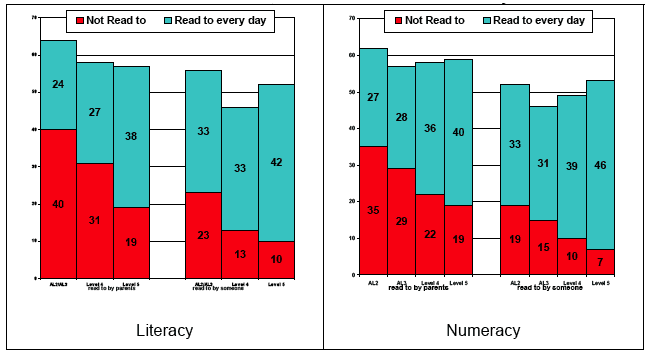
Watching television and reading
There is a view that watching a lot of television has a negative association with the development of reading skills. What we found was that cohort members with SCQF Access Level 2 or 3 literacy were the most likely to have watched four hours or more television a day on the weekend, compared to cohort members in all other skills groups (26% to 10% with SCQF Level 4 or higher literacy skills). On the other hand, when cohort members reached age 10, compared with other parents far fewer parents of cohort members with SCQF Access Level 2 or 3 literacy reported that they 'often' read in their spare time (29% compared with 53% SCQF Level 4 and 64% with SCQF Level 5 or higher skills). Also, at age 16 these cohort members were the least likely to report that they had read a book for pleasure in the four week prior to interview (38% to 67% with SCQF Level 5 or higher literacy).
Parental interest in their child's education
When cohort members were age 10, their current teacher was asked to grade the level of interest parents had shown in their child's education and what attitude they held towards their child at school - 'over concerned', 'balanced', 'dismissive', etc. Figure 4.7 shows that compared with cohort members with SCQF Level 5 or higher skills, cohort members who had SCQF Access Level 2 or 3 literacy were three times less likely as to have had a mother and six times less likely to have a father who was 'very interested' in their education. They were also half as likely to have a mother and three times less likely to have a father with a 'balanced' attitude to their education. Reflecting that fathers traditionally tended to become steadily more involved in their child's education as they progressed through secondary education, teachers felt they 'could not say' about the interest of 1 in 3 of all fathers, presumably as they had not seen them at the school 22. However, this response was highest for fathers of cohort members with SCQF Access Level 2 or 3 literacy (63%) and lowest at 31% for fathers of cohort members with SCQF Level 5 or higher numeracy. When interest of both parents was combined, cohort members with SCQF Access Level 2 or 3 literacy were six times less likely than those with SCQF Level 5 or higher literacy to have two parents who were thought to be 'very interested' in their education. For numeracy groups, cohort members with SCQF Access Level 2 numeracy were half as likely as those with SCQF Level 5 or higher numeracy to have a mother, father or both parents very interested in their education at age 10.
Figure 4.7: Mothers' and fathers' interest and attitude to their child's education when they were age 10 by their grasp of literacy or numeracy
a) Literacy
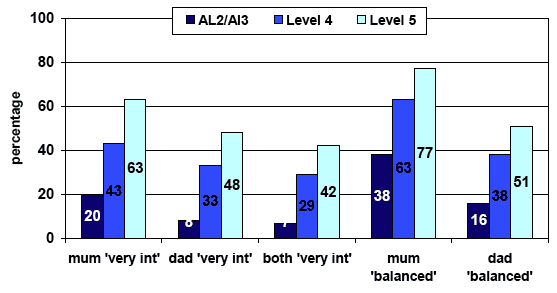
a) Numeracy
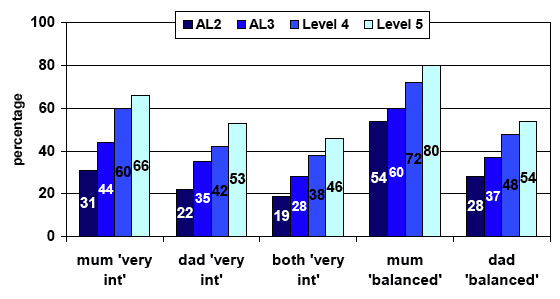
Parents held post-16 education aspirations for their child?
At this time (age 10), parents were also asked if they wanted their child to continue in education post-16. Figure 4.8 shows that cohort members with SCQF Access Level 2 or 3 literacy or SCQF Access Level 2 numeracy were nearly three times as likely to have had parents who wanted them to leave full-time education at the earliest opportunity compared to parents of cohort members with SCQF Level 5 or higher skills. These educational aspirations were replicated in the cohort members themselves. At age 16, although numbers are restricted, more than 8 in 10 children with SCQF Access Level 2 or 3 literacy wanted to leave education at the earliest opportunity as did nearly 6 in 10 with SCQF Access Level 2 numeracy. This compared with 1 in 3 of those with SCQF Level 5 literacy, and 1 in 4 with SCQF Level 5 numeracy.
Figure 4.8: Parental aspirations of cohort members continuing with education (age 10) by cohort members grasp of literacy or numeracy
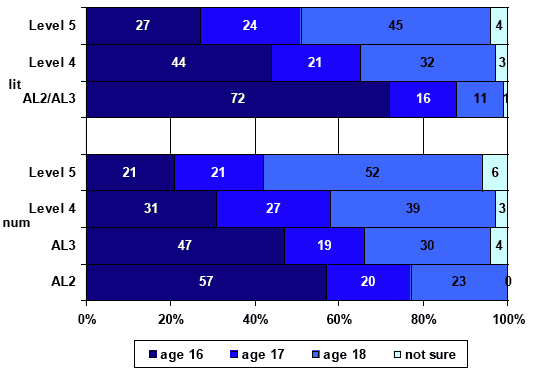
Summary of family background and family support factors
Cohort members with the poorest grasp of literacy and numeracy, particularly literacy, had a relatively disadvantaged home life in childhood, both economically and in terms of education levels and educational support offered by parents. Although more families in Scotland had grown up in rented overcrowded accommodation compared to those across Great Britain as a whole, those with the poorest grasp of literacy in Scotland were the most likely of all to live in such housing conditions. Far fewer parents of cohort members with the poorest skills had enjoyed any extended education or gained any qualifications (87% of mothers of those with SCQF Access Level 2 or 3 literacy had no qualifications in comparison with 43% of mothers of cohort members with SCQF Level 5 or higher literacy). Fewer such parents had read to their children when they were young (40% of those with SCQF Access Level 2 or 3 literacy had been never read to compared with 19% SCQF Level 5 or higher literacy) or been viewed by teachers as interested in their children's education towards the end of primary school. Reflecting their own poor educational experiences, far fewer parents of those with SCQF Access Level 2 or 3 literacy held aspirations for them to continue in education after age 16.
There is a problem
Thanks for your feedback